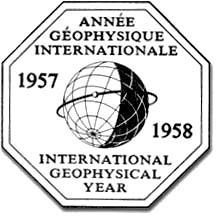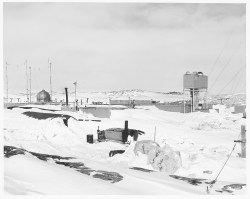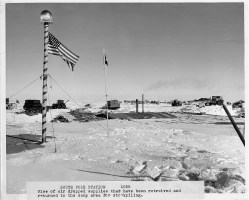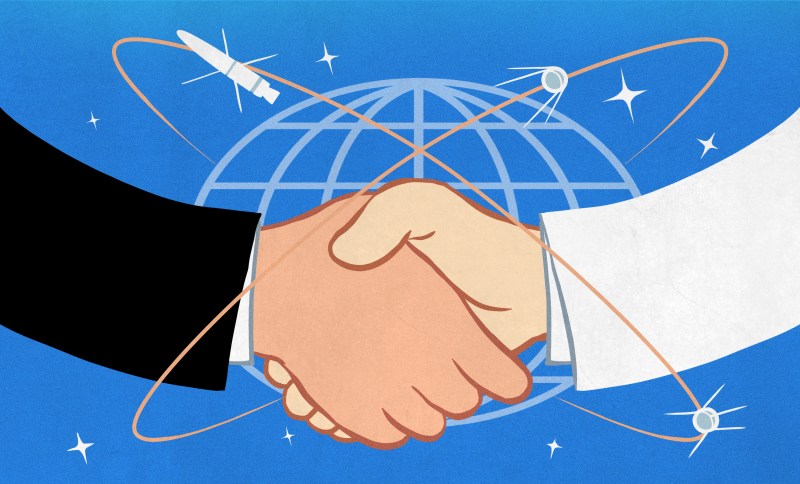If you are a Steely Dan fan, you might know the Donald Fagen song, “IGY.” In it, Fagen sings about a rosy future with high-speed undersea rail, solar power, giant computers making life better, and spandex jackets. Since that song was on the 1982 album Nightfly, it is already too old for some people to remember, but the title goes back even further: the International Geophysical Year which was actually a little longer than a year in 1957 and 1958. The year was a concerted effort by 67 countries to further mankind’s knowledge of the Earth. It was successful, and was big news in its day, although not much remembered now.
The real origin dates back to even earlier. In 1882 and 1932 there were International Polar Years dedicated to researching the polar regions of the Earth. In a way, it makes sense to do this. Why should 60 or more countries each mount difficult, dangerous, and expensive expeditions to such a hostile environment? However, instead of a third polar year, James Van Allen (who has a famous belt) and some other scientists felt that advances in many fields made it the right time to study geophysics. From the scientific point of view, the IGY coincided with the solar activity cycle maximum. But there were other forces at play, too.
The Roster and Politics

The IGY wasn’t just scientific. It was political. After World War II, the cold war prevented the “east” and the “west” (that is, western Europe and the United States along with their allies versus the Soviet Union and their allies) from cooperating. There was little scientific interchange between the two sides.
Another political issue was the results of the 1932 polar year. Because of the war, some of the data and analysis from that year were lost forever because some countries held the only copies of the data. While it is true that China abstained in protest of the inclusion of Taiwan, most major countries participated in some way. The IGY planners decided that all countries would have all the data to avoid repeating the problem with the prior polar year.
Belgian Marcel Nicolet was selected to helm the year of science. While it isn’t as well known as President Kennedy’s “moon” speech, President Eisenhower’s administration announced that the United States would launch “small Earth-circling satellites” under project Vanguard as part of the IGY. The Soviets announced the same intent, but didn’t provide a timetable only saying in August 1956 that it would be “in the near future.” That near future turned out to be October 4th, 1957 when Sputnik circled the Earth. The United States did finally get Explorer I up after several failed Vanguard attempts, but not before the USSR had launched Sputnik 2.
The Internet of 1957
As part of the effort to preserve the data from the IGY, the committee set up the World Data Center system. The United States had data center “A” while the USSR had data center “B.” There was also data center “C” subdivided among various European countries, Australia, and Japan. Each center had a complete copy of all IGY data, often on punched cards or magnetic tape. All data held in the data centers had to be available freely for the cost of copying and sending the information.
This may have been the biggest legacy of IGY. The system expanded to include 52 centers in 12 countries. In 2009, the system merged with another data collection service to form a new system known as the ICSU World Data System.
Brrr…

Like the earlier polar years, the IGY also focused on arctic and antarctic research including the establishment of several antarctic bases some of which are still in operation. A two-man camp on the actual South Pole was to help locate the aurora australis precisely and study emperor penguins.
If you’ve heard of Byrd, Ellsworth, Amundsen-Scott, Wilkes, Hallett, Little America V, or McMurdo, they were all built during IGY or built in anticipation of it. McMurdo and Amundsen-Scott stations are still in operation. The McMurdo station can house over 1,200 people in 85 buildings.

The Amundsen-Scott station houses around 150 people during the summer (when it is daylight for six months) and about 50 people during winter (six months of darkness). The original station was abandoned in 1975 and was demolished in 2010 after being buried in snow and suffering from collapses.
In the artic, Ice Skate 2 was a floating research station that mapped the bottom of the Arctic Ocean. In a nail-biting turn of events, the crew lost nearly all radio communication with the outside world for a month.
Legacy
Speaking of Antarctica, IGY led to the establishment of the Antarctic Treaty which led to further cooperation in science among 41 signatory countries. A great deal of data was collected and, perhaps most significantly, distributed by the Word Data Centers.
Scientifically, the Van Allen belts were discovered. Research on ice depth in Antarctica led to a better understanding of glaciers, improved meteorological forecasts, and radically revised the estimate of the Earth’s total ice content. Ocean floors and currents were charted as was the Earth’s magnetic field. New understandings of plate tectonics and the upper atmosphere were also results.
Ready for another IGY? Well, not exactly, but 2007 saw the 4th Polar Year where 60 countries cooperated, again, on polar research. The International Space Station was another multinational effort, although it won’t last forever and, notably, Russia has announced it may want out of it. We would love to see more international science cooperation.
As you might expect, living in Antarctica means you can expect to do a certain amount of hacking. Ham radio, by the way, played a key role in keeping some IGY scientists in touch with loved ones back home. Ham also contributed data to the IGY effort.
















90 minutes from new York to Paris
Under sea by rail
Get your tickets to that wheel in space
The night fly was a Donald Fagen solo album.
That’s why I said the Donald Fagan song and not the Steely Dan song LOL. Unfortunately, for many people you have to introduce him as half of Steely Dan or they don’t know who he is.
Fagen
Can a leopard change his spots?
You mean like spelling it correctly more times than he didn’t?
LOVE that album and all of the Steely Dan ones. On the all getting along thing, it was a largely political competition, at least between the US and USSR.
What a beautiful world it would be
What a glorious time to be free
Fagen’s best work IMHO.
As a comment on the polar expeditions, my 1C2R Tasman James Spaulding went to the Antarctic aboard the Terra Nova to rescue Cmdr Robert Scott and was awarded the Polar Medal. Due to a clerical error he never received the medal or even knew of it, and it was discovered in the drawer of a British bureaucrat 100 years later. It’s now on display at the Maritime Museum in Hobart. He was the only Australian aboard, having replaced a Scotsman who was unfit for duty due to drunkenness.
“The International Space Station was another multinational effort”
Yes, but let’s don’t totally forget the MIR. It wasn’t intended as a multi national project, it effectively served as one in its last years. ISS’ predecessor welcomed astronauts of different nationality, at least. It also served as a harbor for space shuttles and had an amateur radio station. Ironically, that station was much more human than the one on the ISS. Cosmonauts and astronauts on MIR invested their spare time to casually talk to people via ham radio. A Packet Radio/SSTV station was also installed. On ISS, things are rather robotic, professional. No time for a little chat, mainly school stations get through, because they’re on schedule.
Owen Garriott wanted ham radio on Skylab. But NASA objected, no control over what was said.
But on the space station, it becomes a utility, to give kids a chance to talk to the astronauts. Everyone going up seems to have a ham license. Surely a combination of obligation, and easy licensing. It is a little odd, the same thing could be done through regular communication, though harder to set up at schools
“Owen Garriott wanted ham radio on Skylab. But NASA objected, no control over what was said.”
That’s sad, Skylab was an interesting little station. So many missed opportunities.
Well, at least the 1980s shuttle missions had amateur radio on board. Even Packet Radio/E-Mail and SSTV occasionally.
Also, wasn’t a later Apollo mission supposed to install a ham repeater on moon? Including a little SSTV camera looking back to earth?
Hm. How was it called again, project Moonray?
“It is a little odd, the same thing could be done through regular communication, though harder to set up at schools”
Hm. The original idea of amateur radio was all about peace, international friendship, being altruistic, a non-commercial mindset (homebrew, developing skills) etc. so it perfectly fits the idea. Afaik, there even were peace talker satellites (dove sats?) which transmitted greetings. And yes, there are still amateurs with ideals out there.
There are many hams around the Johnson Space Center that make sure nearly all of the astronauts get licensed. One of them who is now a silent key, Nick Lance KC5KBO, also was very dedicated to bringing ham radio to school kids. His classes minted probably hundreds of new hams. Sure, some of them lost interest quickly, but some didn’t and many may yet return. 73 Nick SK.
Thank you Al for this informative article. It is an enjoyment to read. This article has rekindled my interest in Antarctica studies. The Night Fly album was one of my favorites when it came out.
I enjoyed the article as well. Thank you for sparking the urge to learn more.
Politics produces peculiar results. The U.S. could have put up a satellite first on a Redstone rocket, but Redstone was a military design and Eisenhower wanted a civilian rocket to go up first. Hence the Vanguard, which failed.
Could have sent the wrong message.
Eine alte V2 wäre vermutlich auch nicht so toll gewesen. ;)
(An old V2 wouldn’t have been that great, either, probably.)
Actually Vanguard was based on a NRL designed sounding rocket, a Viking. Amd very advanced, far more so than the Jupiter C design which finally delivered Explorer 1. In fact Vanguard 1 is still in orbit, despite becoming a silent key of sorts after about a month at work, after being launched by NASA shortly after they perfected the bird design.
It is Donald Fagen, not Fagan.
I remember it well though I was very young. National Geographic had issue after issue of the coolest findings and expeditions. I think the IGY provided years worth of material. It was an incredible time for child science enthusiasts. Sputik orbited that same year and in a decade Niel and Buzz were on the frikin Moon! At that pace a lot of kids my age expected to have careers in space on the Moon or on stations or ??? Have Spacesuit Will Travel.
In 1960 Trieste dove to the bottom of the Challenger Deep and in ’62 Jeaques Custeau stared the Conshellf projects. SO, there were the career opportunities in the coming cities beneath the sea.
Hmm.. Kind of surprised and concerned not to see N2CQR in the comments of this one. I hope he’s ok!
The only thing anyone seems to cooperate on these days is war in Ukraine.
Such cooperation seems to be entirely predicated on where and what the nation is: European and NATO nations are MOSTLY (Hungary, Serbia, Turkey) cooperating, but outside of Europe, the Commonwealth, and the United States all bets on cooperation are off. China, India, most of Africa, South America, and some of southeast Asia are neutral at best. The world is far from united against Russia’s imperialism.
Everyone cooperates on TCP/IP and related protocols.
Great article! :-) Now I also need to listen to that Fargans Knightfly.